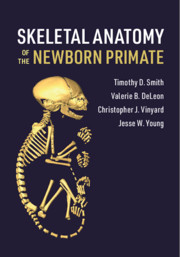Book contents
- Skeletal Anatomy of the Newborn Primate
- Skeletal Anatomy of the Newborn Primate
- Copyright page
- Contents
- Foreword
- Preface
- 1 Introduction
- 2 Primate Development and Growth
- 3 Why Ontogeny Matters
- 4 The Skull
- 5 Dentition
- 6 The Postcranial Axial Skeleton
- 7 The Pectoral Girdle and Forelimb Skeleton
- 8 The Pelvic Girdle and Hindlimb Skeleton
- 9 The Newborn Primate Body Form: Phylogenetic and Life-History Influences
- 10 Ontogeny of Feeding
- 11 Ontogeny of Locomotion
- References
- Index
- Atlas
2 - Primate Development and Growth
Published online by Cambridge University Press: 23 March 2020
- Skeletal Anatomy of the Newborn Primate
- Skeletal Anatomy of the Newborn Primate
- Copyright page
- Contents
- Foreword
- Preface
- 1 Introduction
- 2 Primate Development and Growth
- 3 Why Ontogeny Matters
- 4 The Skull
- 5 Dentition
- 6 The Postcranial Axial Skeleton
- 7 The Pectoral Girdle and Forelimb Skeleton
- 8 The Pelvic Girdle and Hindlimb Skeleton
- 9 The Newborn Primate Body Form: Phylogenetic and Life-History Influences
- 10 Ontogeny of Feeding
- 11 Ontogeny of Locomotion
- References
- Index
- Atlas
Summary
Birth represents a transitional point in time – a static moment that borders a time of complete dependency and the march toward independence. This chapter reviews some basic concepts of vertebrate development and histology. Of particular relevance are tissue changes that reflect differentiation of mineralized tissues: skeletogenesis and odontogenesis, beginning with changes to the primitive connective tissue (mesenchyme). Viewed by microscopy, mesenchyme condenses prior to differentiation into cartilage, bone or tooth germs. Most mesenchymal condensations for the skeleton form during the embryonic period, but they continue to appear during the fetal period or postnatally for some structures (e.g., successional teeth). Most growth of the skeleton occurs during the fetal and postnatal periods. Mineralized connective tissues have different available growth processes. The contributions of appositional growth (new matrix is added to existing matrix), interstitial growth (cell replication and matrix production within existing tissue), and bone modeling (selective osteoclastic and osteoblastic activity) are discussed according to types of bones and skeletal regions.
Keywords
- Type
- Chapter
- Information
- Skeletal Anatomy of the Newborn Primate , pp. 9 - 27Publisher: Cambridge University PressPrint publication year: 2020



